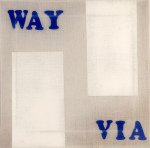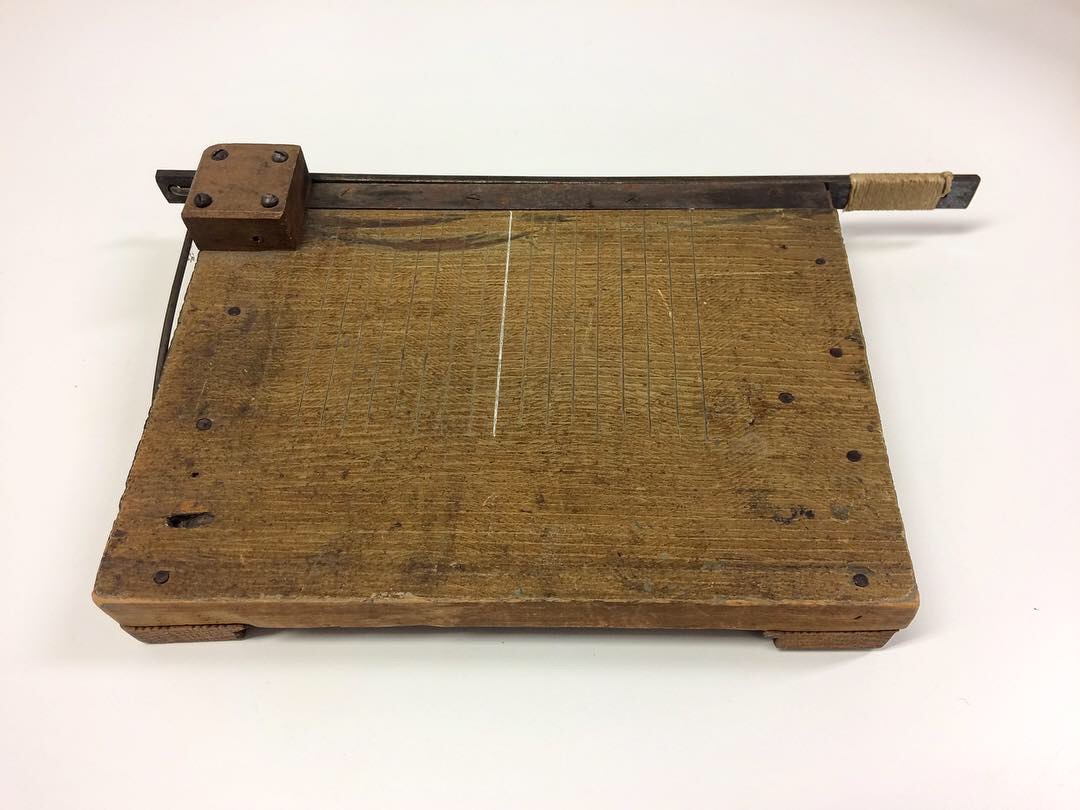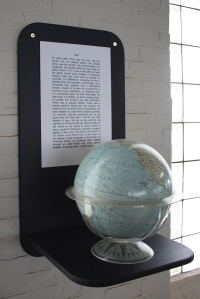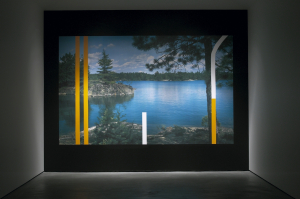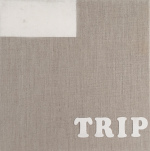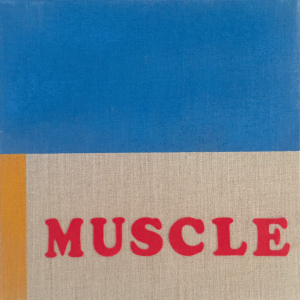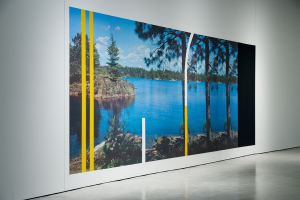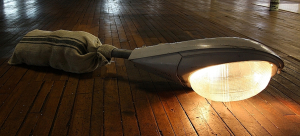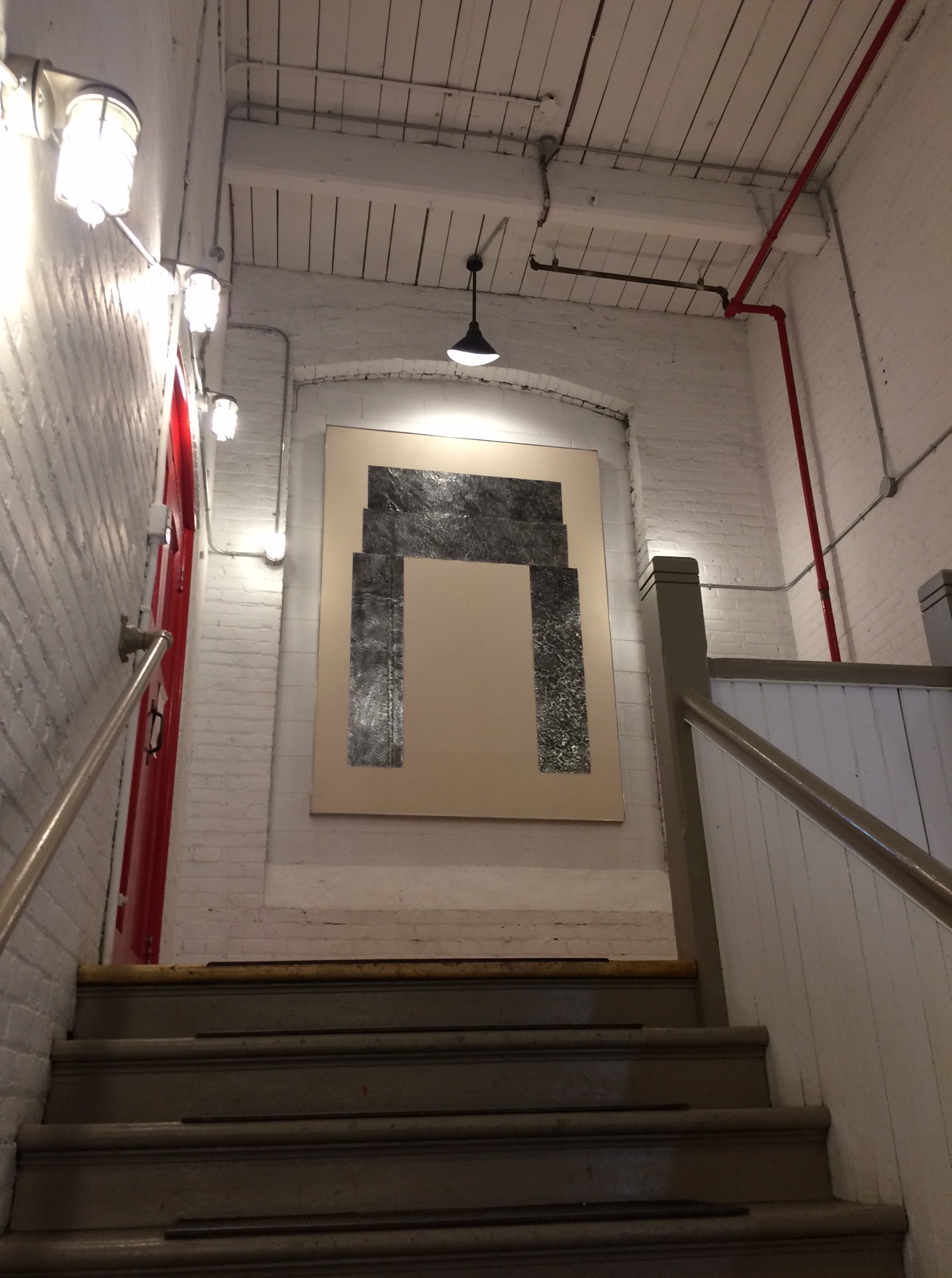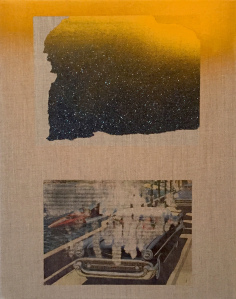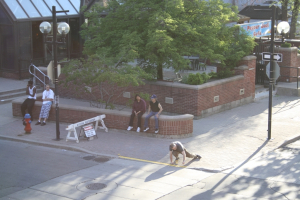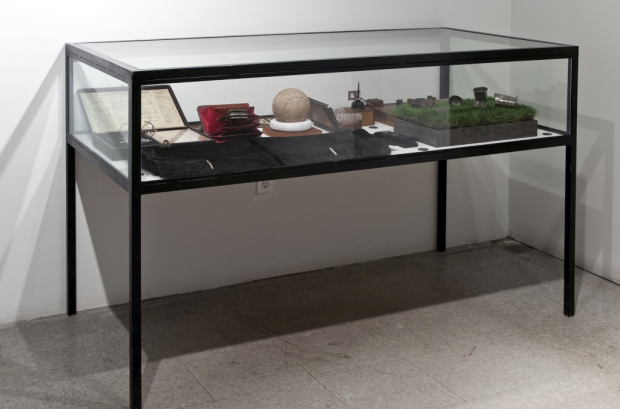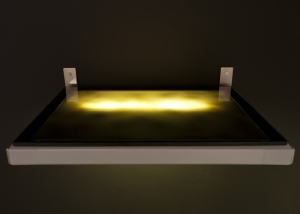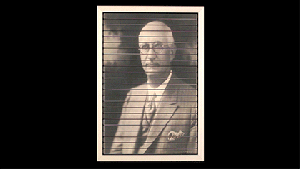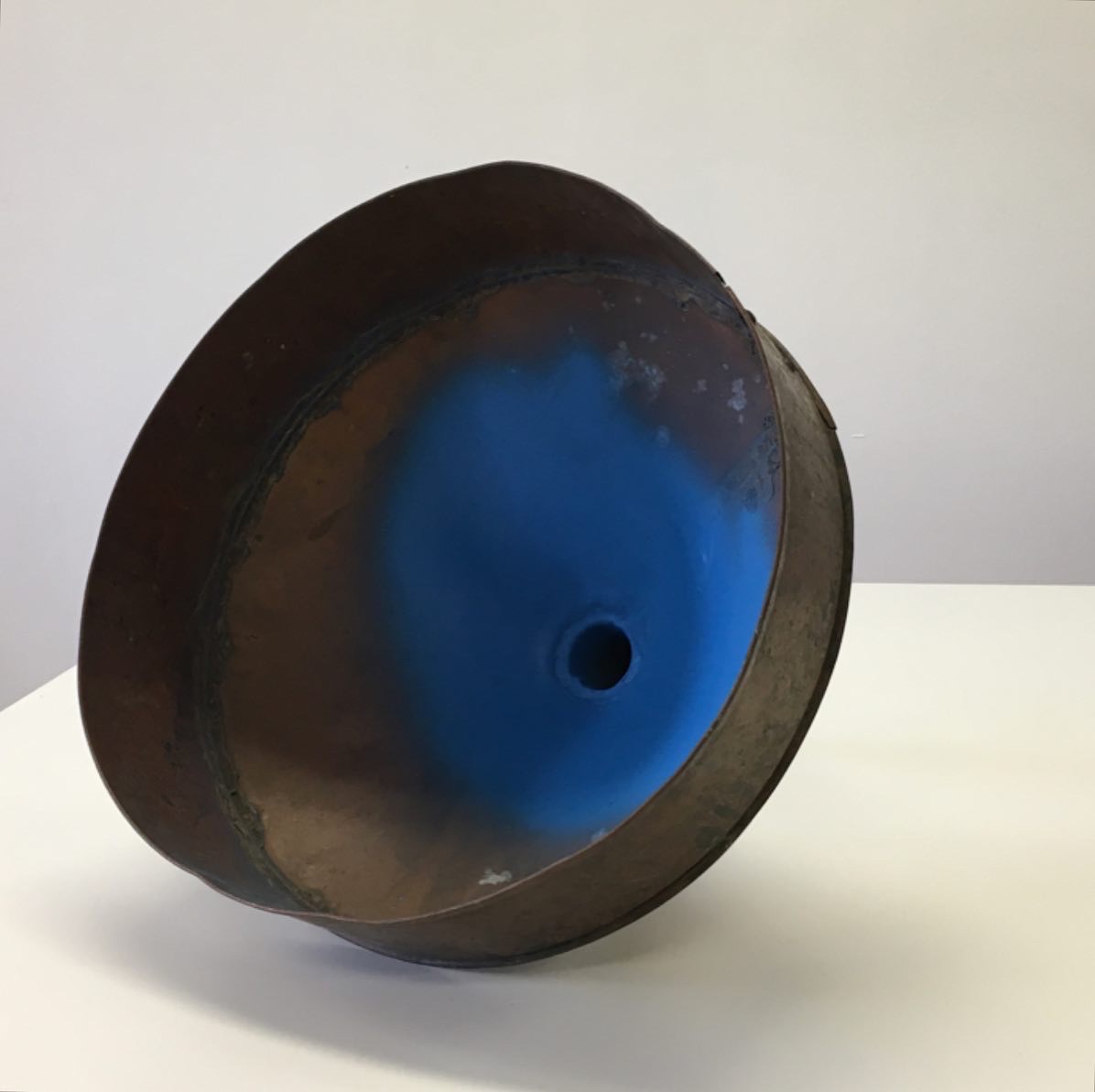by Keir Stuhlmiller
The demarcation and identification of place – engaging both social behaviour and a sense of location – is a complex act of synthesis defining urban regeneration and evolution on a global scale. While the current project WHITE ROMA/WHITE PELEE by C. Wells examines a natural expansion of the mantra ALL ROADS LEAD TO ROME, his unique exploration of place, event, and a codification of details brings his artistic practice into immediate play with established structures of urban form and organization.WHITE ROMA/WHITE PELEE expands upon Wells previous work with line marker works through the re-contextualization of these marks in the urban environment. By reflecting upon the urban structure which has governed Rome’s several rebirths and metamorphosis through history, the location of the line marker performance piece proposes a complex relationship between Rome and Point Pelee – the similarity of the code and their shared location in Latitude. An ‘association by trajectory’ to – quote Wells directly. As one views the performance showing Wells repainting the line markers in situ at Point Pelee, both the medium and form of the line mark – codified as a universal standard in modern transportation and direction – demonstrate their resistance to spatial evolution which surrounds them. The marks retain relevance through their simplicity not as objects, but as code for individual perspective/behaviour/comprehension. The latitudinal affiliation between Rome and Point Pelee questions how one can disperse, receive and integrate cultural codes.Rome has functioned – historically/culturally/socially/politically/economically – as a core of dispersion. Roman roadways were aligned to radiate out from the city core – ensuring that to travel to the city one would directly follow a sequence of roads, linked through secondary and tertiary cities, until they arrived at the primary core – Rome. The mapping itself evokes individual behaviour – one is being LEAD BACK TO ROME. The implication of the movement, regardless of whether or not the return to Rome is completed, powerfully locates one as inevitably existing within the larger scope of a single location. The project WHITE ROMA/WHITE PELEEarticulates this subscript of the city – redefining the Actual (physical, Rome, the ‘map’) within the Perceptual (process, economics/transfer of information/politics).
While Rome illustrates a synergy between form and function, this is recaptured in the modernist edict ‘form follows function.’ Modern considerations of spatial organization embraced the ideal construct of the Cartesian grid – an infinitely flexible and unified grid giving order to space and extended to urban form. The system offered limitless options for defining space as equally accessible from any point on the grid. The dissolve of this continuous grid in contemporary urban space is discussed by Albert Pope with the term “ladders” to investigate “the increasingly fragmented grid which is the residue of its production. This residue is associated with the emblematic figure of the ladder, the remainder of a partially eroded grid.” The evolution – or dissolve – of urban functionality impacts the universal communication of established urban codes – such as the line marker. While line marks denote meaning and function within individual contexts, their universal application signifies a condition of contemporary urban form – fluctuation between location and dislocation.
Spatial organization on an open, infinite Cartesian grid suggests an idealized functionality for the Modernist city. This form would allow for open inhabitation and the ability to utilize all facilities through direct access. Functionality is infinitely available while the ‘use’ of a space is defined by the user. As the grid continues to dissolve, utilization is inhibited and redefined. The code of the line marker – guidance – which has become synonymous with the road – access – is altered through experiential knowledge that the line mark no longer defines the direction of a continuous axis, these lines are increasingly dislocated and partial. Pope states that:
The gridded space which we actually produce is not an open vitalist field connected to the world: it is not centrifugal. It is rather the abbreviated, closed, enclave of centripetal organization. The contemporary world is imploded, leaving behind nothing more that spurious representations of otherwise indispensable continuities.
As the continuity of urban form evolves and use of space is redefined, contextualization of established codes becomes blurred. These codes, however, retain both their physical form and application regardless of the shifting context.
Subsequently, as the Modernist urban grid and the radiating roadways of Rome define ‘use,’ the codification of the line marker evolves. The marker – through its application to all systems of urban order – challenge behaviour and public perception of order within urban space. To draw parallels with the urban system of Rome is to engage an order founded on a pure understanding of use. Wells’ recognizes this in referring to the final visual sequence of Federico Fellini’s film ROMA. This sequence displays a condition of urban Rome – the ability to negotiate location through purely spatial relationships. Sequences of places –architecture, urban monuments, views, approaches – reveal location through spatial relationships. It is through this layering of spatial experience that one orients oneself – the specificity of a place and the unique elements identify location. This specificity does not undo its use, but prescribes it in a way no longer applied in urban context. This change in codes, spatial relationships, and urban flow define different ideals of ‘use’ rather than ‘function.
Within WHITE ROMA/WHITE PELEE, Wells’ dissection of the line marker considers both the significance of ‘space’ to identifying ‘location’, and a coded medium – line marker paint – to the regulation of ‘use’. In the painting WHITE ROMA / WHITE PELEE, the tonal variance illuminates the different sources of the two paints – the regions of Pt. Pelee (Canada) and Rome (Italy). Although designed and intended for the same use – advocated as identical substances – in the urban context they are revealed as possessing unique qualities. Light, position, and contents subtly redefine the line mark, introducing difference. The regional discrepancy illuminates individual variables specific to each paint – a difference of content. Different urban context inevitably infuses the code. This medium within the gallery distils experience, providing a moment to consider the nature of the media rather than their intended function. The intent of the ‘marker’ remains intact through recognition, but pure perception responds to the minute differences, revealing that there exists a relationship of location versus source. Wells’ distillation applies counterpoints existing within the media itself – revealing both location and dislocation in the use of the paint. Unlike its previous mapping application, the media in a self referential context illuminates an idea of simultaneity – that the line marker’s coded use can be universally applied, and this authentic role brings the specificity of location into question. As line markers are recognized as an emblem inherent to urbanized space, their context(s) become foils to the placed marks, dislocating through the homogenous application rather than defining individual conditions.
Through the contrasts revealed in the line marker paint, Wells’ exhibition unifies the conditions of open context – the universal application of the line marker and individual content – the minutia that differentiate between the paint from different regions. This simultaneity within the work reveals to the viewer the fluctuation of their own context/location. Inevitably, the line marker in Rome and Point Pelee signify diversity of use while the medium is evidence of a similarity of intention. Wells’ work shares a sense of purpose found within the writings of Sanford Kwinter. Kwinter defines a new sense of urbanism which possesses fluctuating spatial relationships and simultaneity within perceptual fields. He defines a ‘soft urbanism’ in which:
at once the medium of circulation for populations, information, commodities and rumors; a complex formation of sovereignties and a shifting perceptual field… when considered as a field, the contemporary city rejoins those irreconcilable questions that overturned classical physics and the plastic arts at the beginning of the twentieth century. The idea of a space-time continuum, its diffusion throughout scientific and artistic experimentation and the bleak deficiencies of all maps relaying on Euclidean principles betray the emergence of a new perceptual field.
Kwinter’s discussion regards traditional ideas of exteriority and mapping as necessarily evolving in perception. In the context of contemporary theory and communication, temporality has infiltrated subject/object relationships, allowing subject and object to shift into relative roles within unique contexts. Visual and spatial logics are subject to simultaneous exposure and engagement, evolving how individuals perceive their contexts – the physical versus the process/perception. As Wells’ proposes a purity of perception to question states of location and dislocation, the perception of the line marker simultaneously defines contexts in Rome and Point Pelee.
The refined palette presented by Wells in WHITE ROMA/WHITE PELEE – line marker paint, film, photography – present scales of engagement between people and their immediate urban context. The painted marks, the action of repainting, the context photos combine scales of physical interaction and associative meaning – a scale of object contrasting a scale of experience. The line marker. The road. The history. The painting. The space. Wells’ process elucidates the notion of inhabitation and context. The scale of the line mark conjures the latitudinal force of Wells’ practice – demarcating the contemporary significance of the urban system which sustains legible surface and context. The ability of an urban code – such as the line marker – to incorporate affiliated contexts challenges the notion of an urban marker at an individual scale, revealing a broader connection and dislocation of the individual. The urban scale of the city as conceived simultaneously exists with the city as perceived – coexisting as they define one another. It is in negotiating the urban processes of connection, linkage, and evolution, that Wells’ project WHITE ROMA/WHITE PELEE proposes a relevant communication strategy within urban evolution.
Pope, Albert. Ladders. New York: Princeton Press, 1996. p61.
Pope, Albert. Ladders. New York: Princeton Press, 1996. p53.
Feher, Michel and Kwinter, Sanford. “Forward”, Zone 1-2 (New York: Urzone, 1986. p12.

